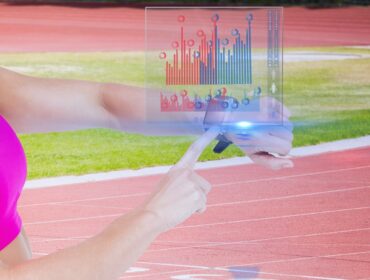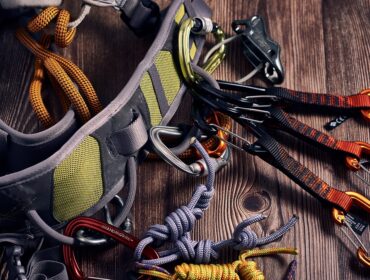Technology has become a defining force in nearly every corner of modern life and sports are no exception. From high school athletes to Olympians, the role of innovation has transformed how we train, compete, and recover. Once reliant solely on human instinct and experience, the world of athletics now leans heavily on data, devices, and digital precision.
In this rapidly evolving landscape, technology in sports is achieving two key goals: making sports safer and making athletes smarter. By using tools like wearables, AI coaching platforms, smart equipment, and advanced medical imaging, athletes and trainers can reduce injuries, maximize potential, and extend careers. Let’s explore how technology in sports is reshaping the future of sports.
1. Wearable Tech: Real-Time Monitoring and Injury Prevention

Wearables are now as important to athletes as cleats or rackets. Devices that track heart rate, muscle exertion, hydration levels, and sleep quality are offering athletes insights previously invisible to the naked eye.
Popular devices:
-
Whoop Strap and Garmin smartwatches for cardiovascular and strain monitoring
-
Catapult GPS vests used in soccer, football, and rugby for movement tracking and load management
-
Motus sleeves for baseball pitchers to detect risky elbow strain
By analyzing these metrics in real time, coaches can spot early signs of fatigue or overuse injuries, adjusting workloads before damage is done. Recovery protocols can also be fine-tuned to ensure that athletes return at peak condition, not too early.
2. AI and Machine Learning in Coaching

Artificial Intelligence (AI) is revolutionizing coaching by analyzing athlete performance with precision. Machine learning algorithms study thousands of movements to detect flaws, suggest corrections, and even predict future injury risks.
Key tools:
-
HomeCourt AI (used in basketball) analyzes shooting form and footwork using smartphone cameras
-
Kinetisense offers motion capture-based evaluations for physiotherapy and training corrections
-
Tonal and Tempo offer resistance training with AI-powered form feedback in real time
AI is especially helpful in remote coaching situations, offering young athletes in underserved regions access to feedback previously only available to elite players.
3. Biomechanics and Motion Capture

Motion capture is no longer confined to film studios. In sports, biomechanical analysis is helping athletes perfect form, reduce wasteful motion, and prevent stress-related injuries.
Applications include:
-
Golfers adjusting swing arcs to reduce back strain
-
Runners correcting gait and foot-strike to avoid shin splints
-
Gymnasts refining dismount angles to improve landing safety
High-speed cameras, pressure pads, and 3D scanners build a visual and statistical picture of an athlete’s body in motion. This helps sports scientists tailor coaching and equipment to match individual needs.
4. Smart Equipment and Enhanced Safety Gear

In contact sports and high-impact disciplines, equipment plays a vital role in athlete safety. Advances in smart gear are reducing the risk of concussions, fractures, and other serious injuries.
Innovative examples:
-
Riddell’s smart football helmets with impact sensors that alert trainers of dangerous hits
-
Babolat Play tennis racquets that track stroke type, ball impact, and swing speed
-
Shock-absorbing pads and exoskeleton gear that protect athletes in sports like skateboarding, motocross, or hockey
This data isn’t just stored; it’s actionable. Coaches can decide when to pull players, refine technique, or even redesign training routines based on gear analytics.
5. Virtual Reality (VR) and Augmented Reality (AR) Training

VR and AR are no longer niche – they’re key tools for cognitive and tactical training. This immersive technology in sports allow athletes to rehearse game situations or fine-tune decision-making without the physical wear and tear.
Sports using VR/AR:
-
NFL quarterbacks using VR to read defenses and practice pocket movement
-
Soccer players using AR for penalty training and goal recognition
-
Boxers and martial artists improving reaction time through simulation drills
VR also enhances mental conditioning, helping athletes visualize routines, stay calm under pressure, and mentally rehearse plays.
6. Injury Detection and Medical Imaging

Medical imaging technology has become faster, more detailed, and more predictive than ever. Ultrasound, MRI, and CT scans now offer near-instant diagnostics, allowing quicker treatment for injuries.
Innovations include:
-
AI-assisted MRI interpretations that detect microtears or inflammation missed by human radiologists
-
Portable ultrasound devices for on-field ligament or tendon assessments
-
Digital thermography to detect heat patterns linked to inflammation before pain begins
Advanced imaging allows teams to create personalized rehab plans, increasing success rates and reducing the risk of reinjury.
7. Smart Fields and Playing Surfaces

Technology is even changing where the game is played. Smart stadiums and fields use sensors to monitor turf quality, temperature, humidity, and even force impact levels.
Use cases:
-
Turf fields with pressure sensors detecting dangerous “hard spots”
-
Basketball courts with embedded chips to analyze foot pressure and jump heights
-
AI-maintained baseball fields that alert groundskeepers to wear and tear
Smart playing surfaces reduce slip risk, improve comfort, and optimize conditions for both training and competition.
8. Nutrition and Hydration Tech

A growing frontier in sports tech focuses on precision nutrition and hydration. Smart bottles, apps, and ingestible sensors are helping athletes stay optimally fueled.
Examples:
-
Gatorade’s GX platform analyzes sweat to personalize electrolyte replacement
-
Lumen measures metabolic rate via breath to guide pre-game meals
-
Smart patches measure sodium loss and dehydration during high-exertion events
Better fuel leads to better performance, fewer cramps, and faster recovery.
9. Data-Driven Game Strategies and Scouting

Sports tech is not just about individuals. Team strategies are also getting smarter with big data and predictive modeling.
How it’s used:
-
In baseball, Statcast tracks player movement, pitch spin, and bat speed
-
In basketball, coaches use player tracking data to optimize rotations and defensive matchups
-
In soccer, heat maps and pass networks help refine tactics and positioning
By blending historical data with real-time inputs, teams can out-strategize the competition while reducing injury risks from overplaying key athletes.
Conclusion: Smarter, Safer, and More Sustainable Sports
We’re entering a golden age where technology in sports is no longer a luxury – it’s a necessity. Athletes, coaches, and teams embracing this tech revolution are finding new ways to push limits without compromising safety or well-being.
From wearables and AI to imaging and AR, the future of sports is being built on science, data, and innovation. These advancements aren’t just making sports safer – they’re helping everyone from weekend warriors to world champions become smarter, stronger, and more resilient.
Whether you’re on the field, the court, the track, or the trail – technology now has your back.
FAQs: Technology In Sports
Q: Which wearable is best for general sports safety and training?
A: Devices like Whoop or Garmin watches offer a well-rounded view of strain, sleep, and heart rate.
Q: How does AI help in sports training?
A: AI analyzes video and sensor data to provide instant feedback on form, fatigue, and injury risk.
Q: Are smart helmets worth it for amateur athletes?
A: Yes – smart helmets with crash sensors can be life-saving, especially in cycling, skiing, and contact sports.
Q: Can VR replace real-world practice?
A: VR can’t replace physical reps but is excellent for tactical training, mental rehearsal, and reaction drills.
Q: Is sports tech affordable for schools and youth programs?
A: Many wearable and AI coaching tools now offer entry-level options suitable for school and recreational use.





